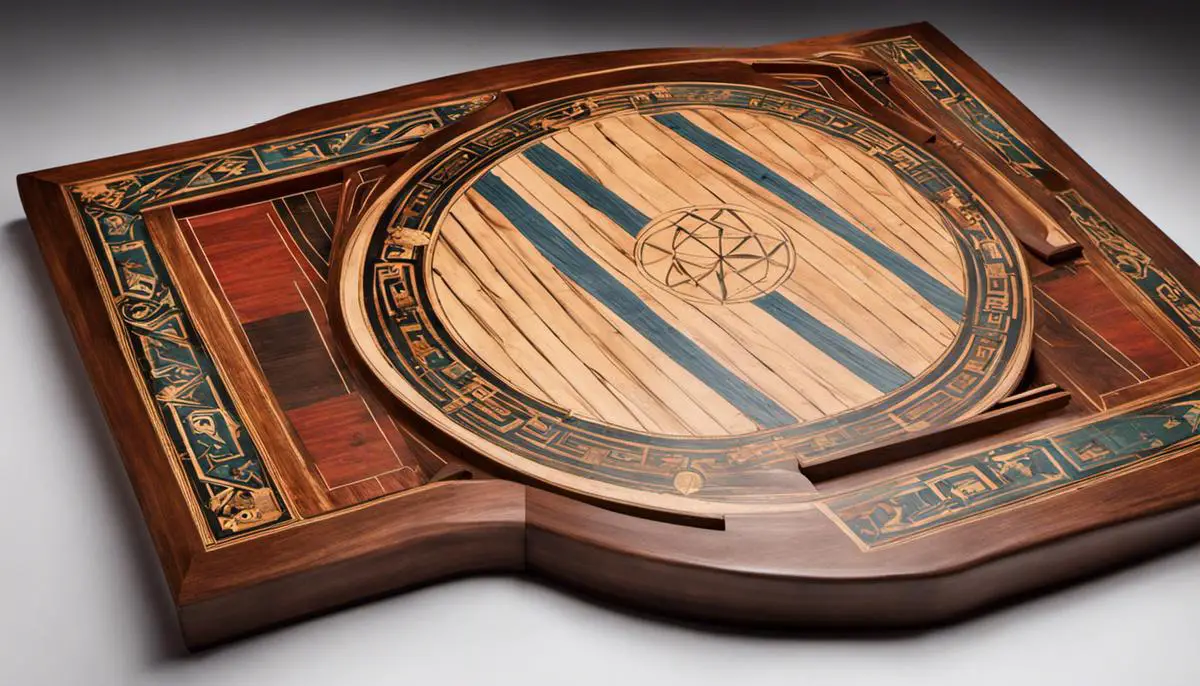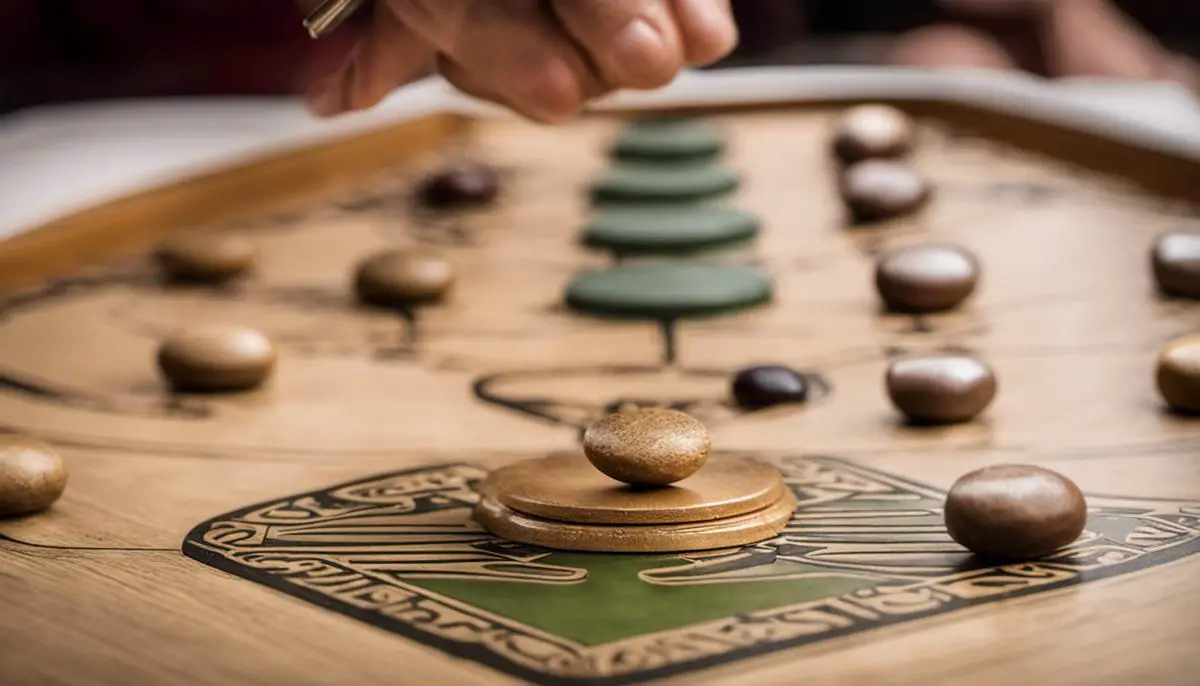As the cradle of Western civilization, ancient Greece introduced a wealth of contributions, profound in art, philosophy, and democracy — but also in the world of games. There’s a particular game, known as ‘Five Lines’ or ‘Pente Grammai’, that resonates spectacularly with the playful intellect of enthusiasts and hobbyists alike. With a measured blend of strategy, luck, and elegance, this game has left an impressive legacy that thrives to this day in its modern iterations. Whether you’re learning how to play, interested in its historical context, eager to win, or planning to craft your own board, this is your one stop guide to the adventurous world of ‘Five Lines’.
Understanding the Rules of Five Lines
Understanding the Game Plot of Five Lines
Five Lines, or Pente Grammai, is an ancient Greek board game that historians believe was played on either a board or a drawn line on the ground. The game’s board consisted of a series of parallel lines. The central lines, also known as the “sacred line,” is thought to be the primary focus or meeting point of the game.
Counters, Pebbles, and Moves in Five Lines
The use of counters or pebbles in the game was essential. These counters were probably made from materials that were readily available in ancient Greece, such as stone, wood, or clay. Each player or team in the game had their own set of colored pebbles which were used to mark their respective positions on the five lines of the gaming area.
The game is thought to have consisted of players taking turns placing their pebbles on the lines with the aim of reaching the central or ‘sacred’ line. The mechanics of moving the pebbles in the game are still a subject of research and debate among historians. Some believe that the players could move their pebbles in any direction along the lines, while others propose that the pebbles could only be moved forwards.
The Winning and Losing Paradigm
Due to the scarcity of explicit historical details, the precise ways to win or lose the game are somewhat speculative. However, the most widely accepted theory is that the first player or team to reach the sacred line with all of their pebbles was the winner.
It has also been suggested by some historians that achieving a certain formation or alignment of the pebbles might have constituted a win. Such theories, though, are unconfirmed and so represent educated guesses based on the evidence currently available.
Appreciating Five Lines in Ancient Greek Heritage
Considered as a significant social engagement in ancient Greece, the game of Five Lines features prominently in a variety of classic literary pieces. Frequently used as a metaphor for strategic acumen and sharp wits in both prose and poetry, the game’s integral role in the society is evident. The frequent cultural references pinpoint towards the significance of Five Lines in ancient Greek times.
While existent comprehensive rules for the game are not available today, the constant reference to it in literature and its presence in archaeological artefacts affirm the game’s influence in Greek culture. Hence, enthusiasts or hobbyists who aim to comprehend and recreate Five Lines can access an intriguing doorway into the practices and pastimes of the people in ancient Greece.

The Historical and Cultural Significance of Five Lines
Understanding the Role of Five Lines in the Greek Cultural Sphere
The game of Five Lines, or Pente Grammai as it was known in its native Greece, was a sensation during the ancient times, more specifically, during the Classical Period (5th – 4th century BC). The numerous artistic representations of people engrossed in the game provide an insight into its importance in the day-to-day life of the Greeks. With participants ranging from children to adults, both males and females, the game was enjoyed at various social events and gatherings. This exemplifies the inclusive nature and the significance of leisure, enjoyment, and communal bonding that was prevalent in ancient Greek society.
Educational Value and reflection of Ancient Greece’s Strategic Thinking
As simple as it may seem, the game of Five Lines held substantial educational value. It involved drawing five parallel lines, with players required to toss pebbles and aim for specific sections or lines. Mastery of the game required strategical thinking, dexterity, hand-eye coordination, and calculation, thereby helping children subtly develop these skills while they played. It also mirrors the strategic thinking that the ancient Greeks were known for. More than just a game, it was a practical tool for honing one’s tactical abilities and cognitive skills, a testament to the far-sighted philosophy of ancient Greeks when it came to education and development.
Five Lines: A Lens into Ancient Greece’s Competitive Spirit
Five Lines serves as a window into the competitive mindset of ancient Greeks. Games were more than just amusement, they were a platform for people to exhibit their skills and outdo others. The high level of competitiveness in Five Lines was akin to that in other aspects of ancient Greek life, such as in the Olympic Games where individuals competed fervently and city-states took pride in the victories of their citizens. This competitiveness has been deeply ingrained in many aspects of modern society, reflecting a continuous influence from these ancient civilizations.
The Transformation and Modern Reach of Five Lines
Throughout the eras, the ancient Greek game of Five Lines has seen countless variations and adaptations, molding itself to the cultural and societal shifts. While its original version might not be as commonly played in the present day, the very essence of the game can be seen interwoven within multiple contemporary games demanding strategic prowess and accuracy. Various outdoor lawn games and beach activities involving tactical tossing including Bocce, Petanque, along with today’s board games that necessitate strategic positioning for winning endorse the enduring legacy of Five Lines. The durability of this game is a testament to the timeless allure of ancient Greek culture, underscoring the intriguing ways an archaic civilization continues to influence the modern world.

Strategies for Winning the Game of Five Lines
Grasping the Fundamentals of Five Lines
Originating in Ancient Greece, the game of Five Lines, also known as Pente Grammai, may be ancient but the guidelines for playing are not complex. Two opponents each have an assortment of differently colored markers. There are five evenly spaced points in a line where participants, in alternating turns, place their marker aiming to create certain patterns before their competitor does. The prospective patterns can be either five in a sequence, five in an arc, or a stack of three markers.
Preemptive Strategies in Five Lines
To become a skilled player of Five Lines, you must first develop a solid game plan. This begins with understanding the game’s structure and the patterns you need to form. It’s always beneficial to play defensively from the start, securing the center point early to maximize your position flexibility. Always aim to establish a base pattern early on, giving you a clear path towards any of the three winning patterns.
Reactive Tactics to Outplay the Opponent
In addition to proactive strategizing, a good Five Lines player needs to adapt quickly to the opponent’s moves. This requires careful observation and effective counter moves. For instance, if your opponent is roughly two moves away from forming five in a row, even if it is not in direct line with your established pattern, you should momentarily abandon your strategy to block them.
Creating a Winning Streak
Winning numerous games of Five Lines demands consistency in your strategies. It’s crucial to be aware of your past successful tactics and continually refine them. This includes reading the board to predict your opponent’s potential moves, understanding how and when to force your opponent to react to your plays, and constantly evaluating your position to build towards a win.
Learning from Classic Games
Studying classic plays is another beneficial strategy. By delving into different game situations, figuring out the best possible moves, and understanding the players’ decisions, you can gain valuable insight. This strategy will not only boost your thinking and decision-making abilities but will also help you anticipate your opponent’s next move efficiently.
Blocking Strategies in Five Lines
Understanding blocking strategies is crucial for a competitive game of Five Lines. Preventing your opponent’s victory is just as important as achieving your winning pattern. You must always keep your opponent in check, breaking their patterns while maintaining and build your own. If your opponent is a move away from winning, your immediate aim should be to disrupt their pattern rather than focusing on forming your own.
Unlocking Winning Strategies in the Ancient Game of Five Lines
To succeed in the age-old game of Five Lines, seasoned players typically rely on well-practiced strategies, tweaking them slightly each round to counter their opponents’ tactics. This might include setting up a triangle pattern at the onset to lead to a rosette formation or creating a line to pave the way for a linear or arc formation. Discovering a winning pattern and consistently implementing it is often the key to mastering Five Lines.

Creating a Five Lines Game Board
Setting Up Your Own Five Lines Game Board: Materials and Steps
Creating your very own Five Lines game board requires just a handful of basic materials. You’ll need a sheet of plywood, a ruler or measuring tape, a pencil, and a straight edge. To give your board a more polished appeal, you might want to paint or stain it – just make sure to include paintbrushes, your chosen paint or stain color, and a protective sealant in your materials list.
Step-by-Step Process to Create a Five Lines Game Board
Start by determining the size of your Five Lines game board. A typical size might be two feet by two feet, but you can adjust this to suit your preferences or available space. Use your measuring tape or ruler to mark the boundaries of the game board on your sheet of plywood.
The next step involves drawing the actual lines for the game. The game board is a cross made of five lines, with three horizontal and two vertical, intersecting at right angles. Each of the five lines need to be of the same length. Use your straight edge and pencil to draw the lines, ensuring they are evenly spaced and intersect properly.
Once you’ve drawn the lines, you can add any additional design elements you’d like, such as a border around the edge of the game board or decorative markings at the intersections of the lines.
Last ly, apply the paint or stain, if you’re using it. This can be a simple solid color, or you can get creative with different colors or designs. When the paint or stain is dry, apply a coat of sealant to protect your game board and make it more durable.
Design Tips for an Authentic Five Lines Game Board
For an authentic Five Lines game board, you might opt for a design inspired by ancient Greek art. This could be geometric patterns, such as those found on Greek pottery, or images of Greek gods or mythological creatures. Do some research on ancient Greek art for inspiration. Remember, the goal is not to create a perfect replica, but to capture the spirit of the game as it was played in ancient Greece.
Accessibility Modifications for a Five Lines Game Board
You can also modify your Five Lines game board to make it accessible for people with different abilities. For example, you could use textured paint or add tactile markers to the lines, making it easier for people with visual impairments to play. Or, you could build a raised edge around the game board to prevent pieces from falling off the edge, making it more accessible for people with motor control issues.
Remember, the most important thing is that your Five Lines game board works for you and the people you’ll be playing with. So don’t be afraid to be creative and make adaptations as needed. After all, board games are all about having fun!

Perhaps it’s the strategic depth, the taste of history, or the sheer joy of play that draws us to ‘Five Lines’. Above all, it is a testament to human intellect and ancient Greece’s love for strategy and problem-solving. Exploring the game, from rules and strategies to crafting your authentic board, we’ve embarked on a stimulating journey, a deep dive into history, culture, and the minds of the ancient Greeks. Wherever your interest in ‘Five Lines’ takes you next, whether you’re refining strategies or entertaining friends at a social gathering, remember the essence of this game – a hearty balance of strategy, luck, and fun. Here’s to channeling the spirit of ancient Greece in every game of ‘Five Lines’ you play.
